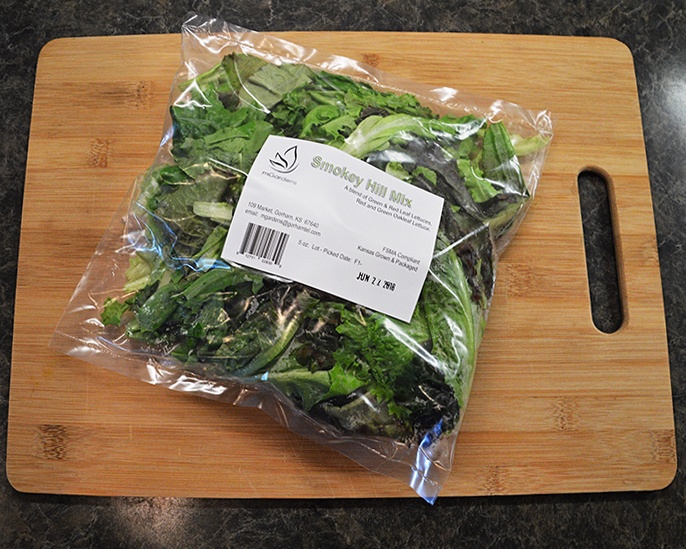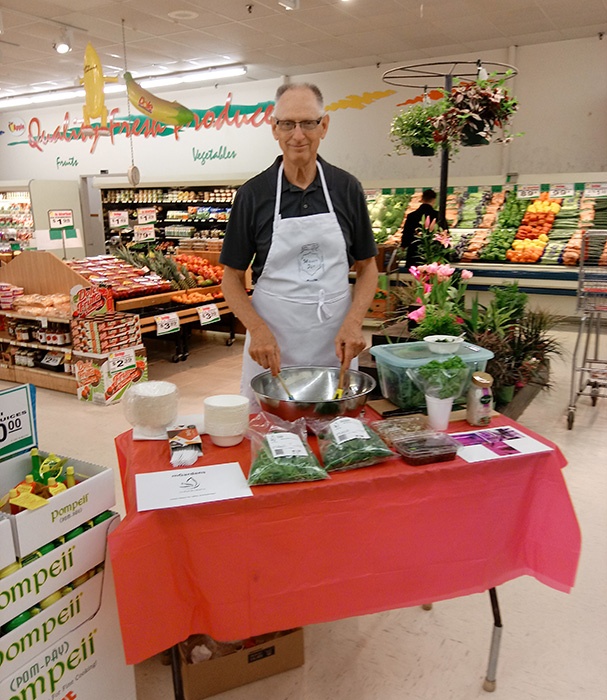mGardens is growing hydroponic leafy greens in rural Kansas and marketing them to local grocery stores, restaurants and a farmers market.
While much of the country’s indoor hydroponic food production is being done by growers located near large urban areas, mGardens in Gorham, Kan., is bucking the trend. Tom Murphy, who is the company’s operator, asked why should people living in or near large cities be the only ones able to enjoy the taste, freshness and nutrition associated with hydroponic leafy greens?
“My wife Jo and I first got interested in hydroponic food production when we talked to Ron Cramer,” Murphy said. “Ron and my wife are from the same home town, went through school together and continue a longtime friendship.
“When Ron retired from Sakata Seed he got interested in hydroponic food production with LED lights. He has been talking to me and my wife for about five years about growing leafy greens. He said more food production is moving in this direction. This is related to the loss of freshness and nutritional value during shipping of perishable crops.”
In 2015, Tom, Ron and their wives met with Chris Higgins at Hort Americas, a horticultural distributor in Bedford, Texas.
“While we were in Texas we visited a Central Market grocery store that is using a GrowRack to offer its customers fresh produce,” Murphy said. “The store was growing hydroponic lettuce in its produce department and marketing it to its shoppers. You can’t get any fresher and local than that.
“We came back home and purchased a three level GrowRack hydroponic unit equipped with LED lights. We started operating it in March 2017 and were very impressed with the taste and quality of our first crops of lettuce, kale and arugula.”
[adrotate banner=”23″]
When Murphy began growing the crops Cramer told him that he would end up producing more food than he knew what to do with. Murphy initially gave the produce to relatives and neighbors.
“The people to whom we gave the produce raved about the taste and the freshness,” Murphy said. “We started playing around with producing a greens mix.”
In September 2017, Murphy put on a salad-making demonstration with the greens mix at a meeting sponsored by the Russell County Economic Development & Convention and Visitors Bureau. At the meeting were local entrepreneurs and business people.
“I explained to the attendees where a lot of our food comes from, how much food is wasted and what we can do to offer fresher, better-tasting food,” Murphy said. “I told them how this food could be grown locally and asked for feedback. Everybody loved the salad. At the meeting was the owner of the local grocery store, Klema’s Apple Market Grocery. He said the store would buy and sell the greens. A solid grocery market was what I felt was needed to start growing commercially.”
Getting serious about growing
After the response from the business community about the greens, Tom and his nephew Mike Murphy and Mike’s wife Tonya decided to set up a commercial operation.
“We prepared a business plan and met with Chris Higgins,” Murphy said. “Chris explained to us that the floating pond system is the most economical way to grow vegetables. So Mike and I converted the three-level GrowRack ebb-and-flow system into a three-level floating pond system.”

Photo by Alison Murphy
Tom ran the floating pond system from July 2017 until January 2018. He was looking for a system that didn’t require acres of land like Hort Americas’ demonstration greenhouse, which he had toured during his trip to Texas.
“I asked Chris how we could adapt a confined totally environmentally controlled area equipped with LED lights into a pond system,” he said. “We ended up designing the system on a napkin.”
The Murphys purchased two old stainless steel refrigeration rail cars that are 40-feet long by 8-feet wide by 9-feet tall. Tom and Mike began working on the system in November 2017.
“We gutted everything out of these stainless steel containers and poured concrete footings because we knew there would be a lot of weight from the pond system,” Murphy said. “We calculated that we could put in two rows of racks. We purchased the pond liners and 8-foot GE LED lights from Hort Americas. Mike did all of the electrical, plumbing and welding.”

Photo by Alison Murphy
Prior to beginning the construction, Murphy said he contacted the USDA to inspect the production system that he and Mike were installing.
“I wanted the USDA to insure compliance with its guidelines,” he said. “USDA officials visited us three times before they did their final walk through to give us a license to operate.
“We also wanted to be FSMA (Food Safety Modernization Act) certified. We had to install a three-basin commercial sink without a connector drain. It had to have an air drain on it. Before we started growing we wanted to make sure that we were compliant with FSMA, even though that law doesn’t go into effect until January 2019.”
Murphy said the company also was required to obtain a grower license as well as a processor license in order to bag the produce for grocery sales.

Photo by Alison Murphy
“Just like a restaurant has to be inspected by USDA, so do we,” he said. “That fit right in with what we were doing in regards to meeting FSMA guidelines. Our main concern is food safety. We’re telling our customers we don’t grow in soil, we monitor for pests and diseases and no insecticides or fungicides are used. The facility is closed to the public.”
Expanding markets
The Murphys began growing in the new production facility in May 2018. Initially they thought grocery stores would take more of the leafy greens, but they are currently taking less than 25 percent of the crops produced.

“The grocery stores have to develop their market,” Murphy said. “They don’t want to buy too much and then watch it go bad. Right now restaurants are buying more. Hickok’s Steakhouse in Hays, Kan., is a higher-end restaurant that was looking for locally-grown produce. It is now buying all of its greens from us and making some unbelievable specialty dishes with our products. North Central Kansas Technical College has a culinary arts program and a catering business and is buying from us.
“We believe our future is in the restaurant business because they tend to use more of our product on a consistent basis. Our goal is to grow 100-150 pounds of produce per week. We built the system so we could double our production capacity if needed.”
Trialing new crops
When Murphy was doing all of the production in the GrowRack, he tried various crops. While lettuce, kale, arugula and basil are his core crops, he continues to try new species and varieties.
“We buy all of our seed from Johnny’s Selected Seeds,” he said. “After experimenting with these crops, if they are going to be grown commercially, it’s all based on turns per square foot. This is where growing in the GrowRack for a year really helped us. When we started growing in the pond system we were ready to go. We had already selected the crops that we were going to grow. We plant about 1,000 plants per week.”
For more: mGardens, (785) 637-5604; mGardens@gorhamtel.com.
This article is property of Urban Ag News and was written by David Kuack, a freelance technical writer from Fort Worth, TX.


